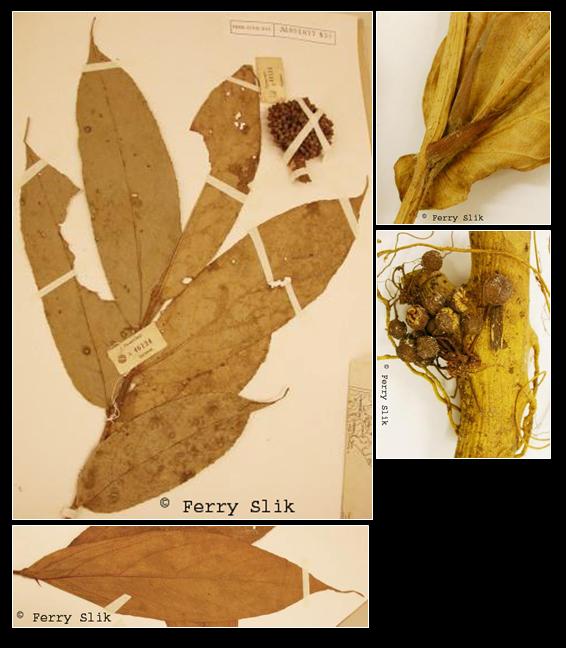Ficus hemsleyana King, Sp. Ficus 2 (1888)
Named after W.B. Hemsley [1843-1924], a British botanist.Diagnostics
Understorey tree (strangling) up to 12 m tall and 24 cm dbh. Stem with white
sap. Stipules ca. 14 mm long, hairy. Leaves alternate, simple, penni-veined,
hairy below, base strongly asymmetrical, margin wavy, tip pointed. Fruits ca. 6
mm diameter, yellow-orange-red, globose figs placed on the stem in small, globose clusters.
Description
Dioecious tree, up to 12 m tall, 24 cm diameter, or climber. Twigs c. 0.3 cm thick,
grey-white, slightly angled, covered with reddish brown hairs. Stipules lanceolate, acute,
1.5-1.8 cm long, brown hairy, subpersistent. Leaves spirally arranged, thin-coriaceous,
sessile, reddish brown hairy below to almost glabrous; oblong, 19-35 x 5-13 cm, base
distinctly auriculate on one side, margin toothed, apex acuminate, acumen 4-5 cm long;
midrib raised above, keeled below; lateral veins 7-10 pairs, steeply ascending, raised
below, sunken above, basal pairs extending to almost 1/2 the length of the blade, with
a gland in each axil below; intercostal venation reticulate to scalariform, visible below,
distinctly sunken above. Syconia in clusters on tubercles arising from the stem, globose,
0.4-0.6 cm diameter, ripening orange, glabrous or hairy, apex depressed; peduncle 0.7-
1.5 cm long; basal bracts 2-3, minute; internal bristles few, minute. Tepals 3-5, oblong
or ligulate, free or slightly joined at the base, white to red-brown. Achenes ovoid, c.
1.5 mm long, distinctly keeled at the apex. [from Tree Flora of Sabah and Sarawak]
Ecology
In undisturbed mixed dipterocarp to sub-montane forests up to 1600 m
altitude. Usually on alluvial sites near or along rivers and streams. On clay to
sandy soils, but also on limestone.
Distribution
Borneo.
Local names
Borneo: Akar karak, Kara (Iban), Lunok (Kenyah), Tuban.
